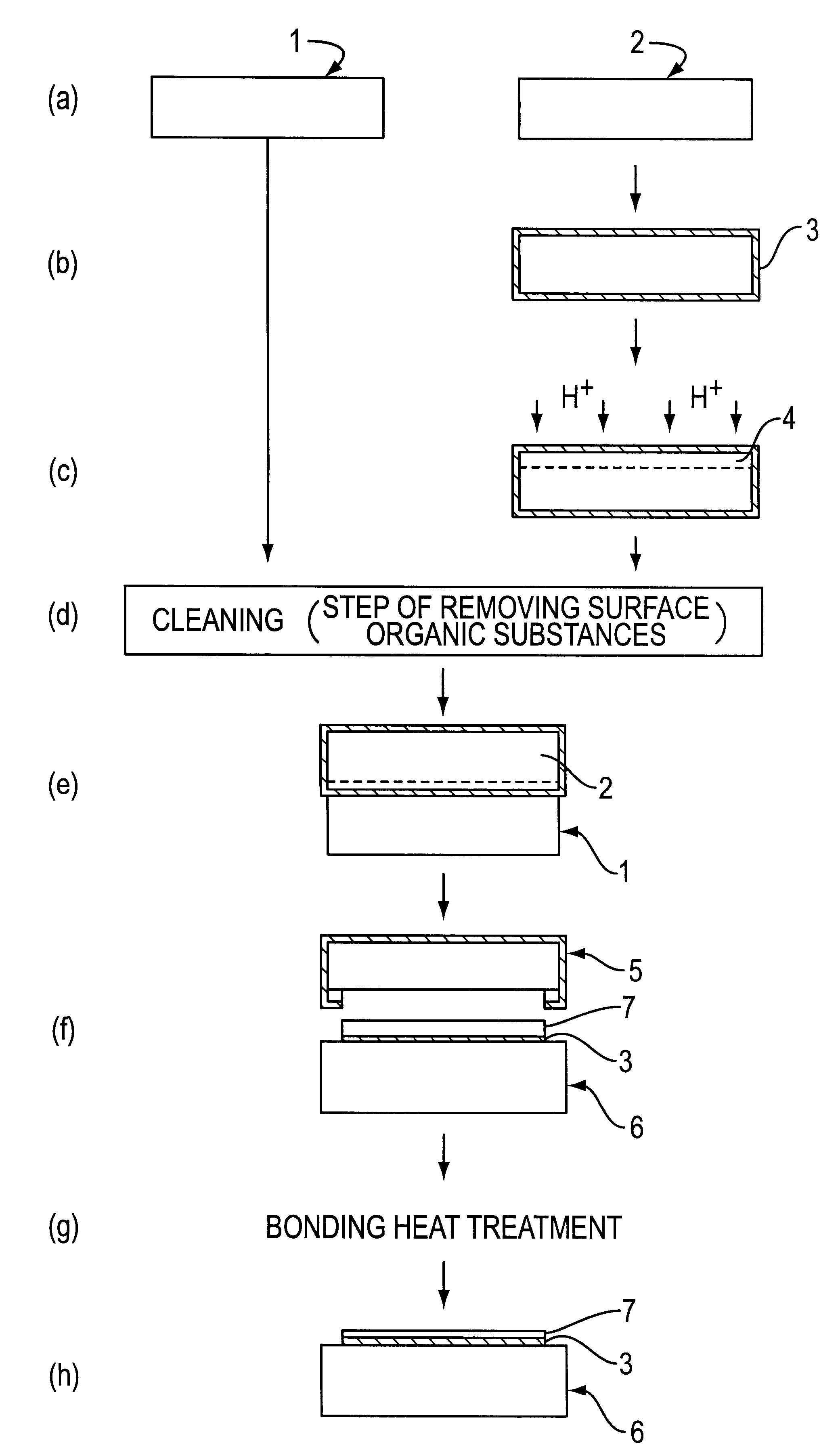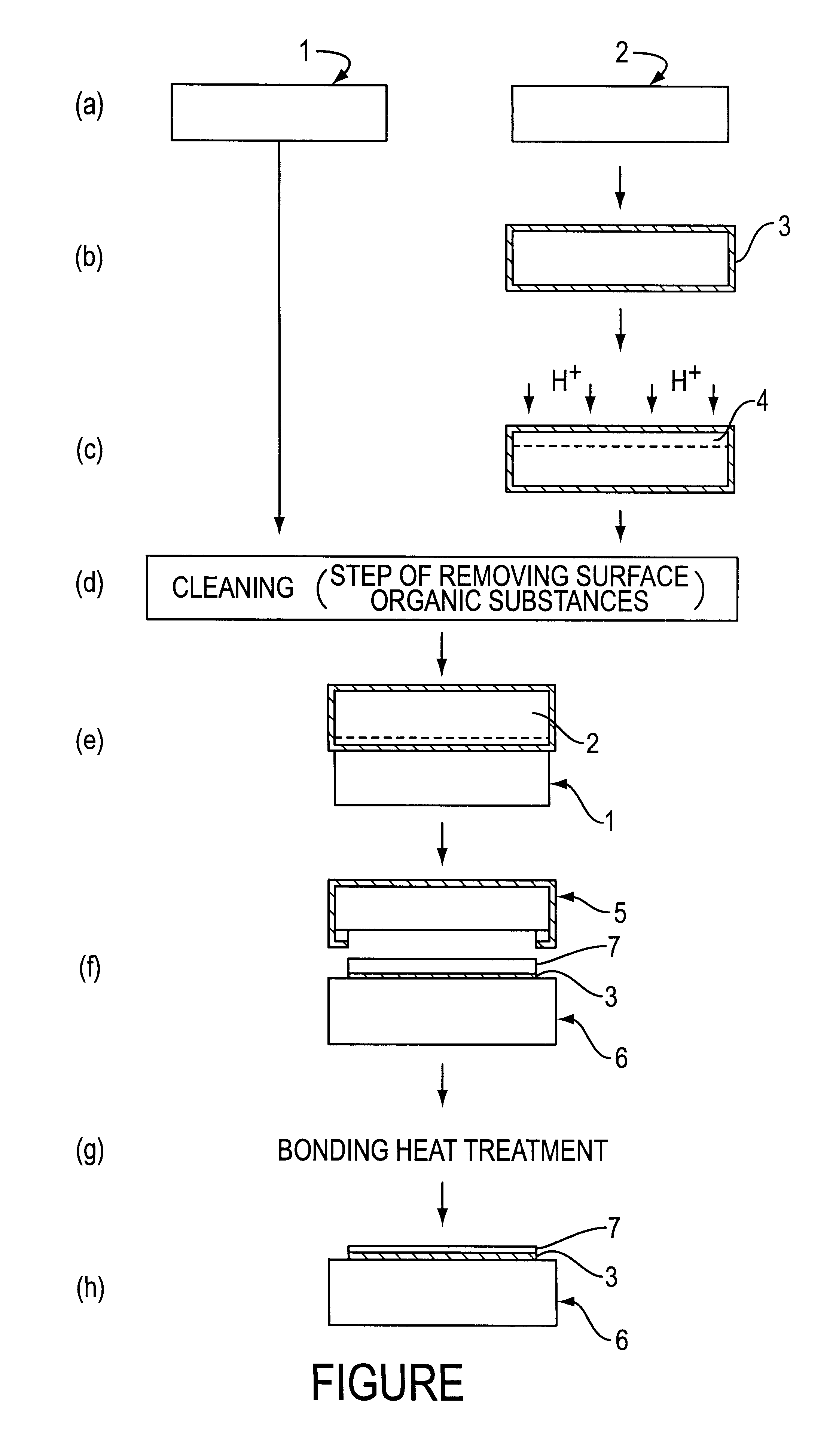Method for manufacturing bonded wafer and bonded wafer
a technology of bonded wafers and manufacturing methods, applied in the direction of instruments, natural mineral layered products, transportation and packaging, etc., can solve the problems of inferior bonding, long time-consuming and labor-intensive thin film making, and waste of material application
- Summary
- Abstract
- Description
- Claims
- Application Information
AI Technical Summary
Benefits of technology
Problems solved by technology
Method used
Image
Examples
embodiment
Preferred Embodiment
Example 1
At first, two single-crystal silicon wafers 2 having a diameter of 150 nm, a thickness of 625 .mu.m, a conductive p-type, and a resistivity of 10 to 20 .OMEGA..multidot.cm with its one surface being polished in mirror surface were prepared, one of the wafers was formed as a bond wafer and an oxide film having a thickness of 0.1 .mu.m was formed at the surface by a thermal oxidation.
Then, H+ions were implanted at the mirror surface side of the bond wafer through an oxide film under a condition of an implanting energy of 40 keV and an implanting dose 8.times.10.sup.14 atoms / cm.sup.2, thereafter sulfuric acid-hydrogen peroxide cleaning (96% concentrated sulfuric acid:30% H.sub.2 O.sub.2 =6 kg:100 cc, a liquid temperature of 110.degree. C.) was carried out for 5 minutes, rinsed with pure water, thereafter SC-1 cleaning (29% NH4OH aqueous solution:30% H.sub.2 O.sub.2, pure water=1: 1: 8, a liquid temperature of 80.degree. C.) was carried out for 4 minutes, an...
example 2
The bond wafer in which the wafer of the same kind as that of the preferred embodiment 1 was not formed with an oxide film, but ion implanted under the same condition was manufactured and kept in a desiccator containing dibutylbenzoquinone therein for 1 hour.
After this period, the cleaning with sulfuric acid-hydrogen peroxide was not carried out, but only the SC-1, SC-2 and SC-1 cleanings were carried out under the same condition as that of the preferred embodiment 1 together with the base wafer and after drying them, both wafers were closely contacted to each other at a room temperature, the same separation heat treatment and bonding heat treatment as those of the preferred embodiment 1 were carried out in sequence. As a result, several voids with a diameter of about 2 to 10 mm were generated at the SOI wafer after the separation heat treatment and their numbers at the SOI wafer were increased after the bonding heat treatment was carried out. However, a phenomenon in which the enti...
example 3
Except the fact that an oxide film with a thickness of 0.1 .mu.m was formed at the bond wafer, a plurality of SOI wafers were manufactured in which operations up to the bonding heat treatment were carried out in sequence under the same condition as that of the preferred embodiment 2. As a result, no voids were observed at all at any kinds of SOI wafers after performing the separation heat treatment, although there occurred cases in which several voids were generated after performing the bonding heat treatment and the other cases in which voids were not generated at all.
PUM
| Property | Measurement | Unit |
|---|---|---|
| thickness | aaaaa | aaaaa |
| temperature | aaaaa | aaaaa |
| temperature | aaaaa | aaaaa |
Abstract
Description
Claims
Application Information
 Login to View More
Login to View More - R&D
- Intellectual Property
- Life Sciences
- Materials
- Tech Scout
- Unparalleled Data Quality
- Higher Quality Content
- 60% Fewer Hallucinations
Browse by: Latest US Patents, China's latest patents, Technical Efficacy Thesaurus, Application Domain, Technology Topic, Popular Technical Reports.
© 2025 PatSnap. All rights reserved.Legal|Privacy policy|Modern Slavery Act Transparency Statement|Sitemap|About US| Contact US: help@patsnap.com


